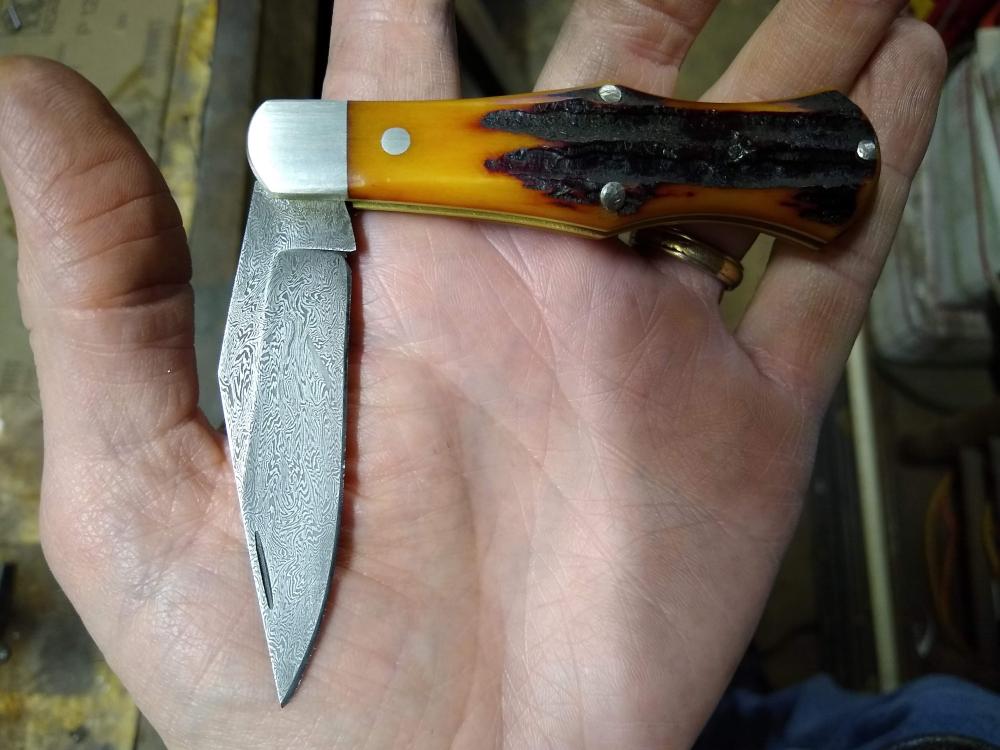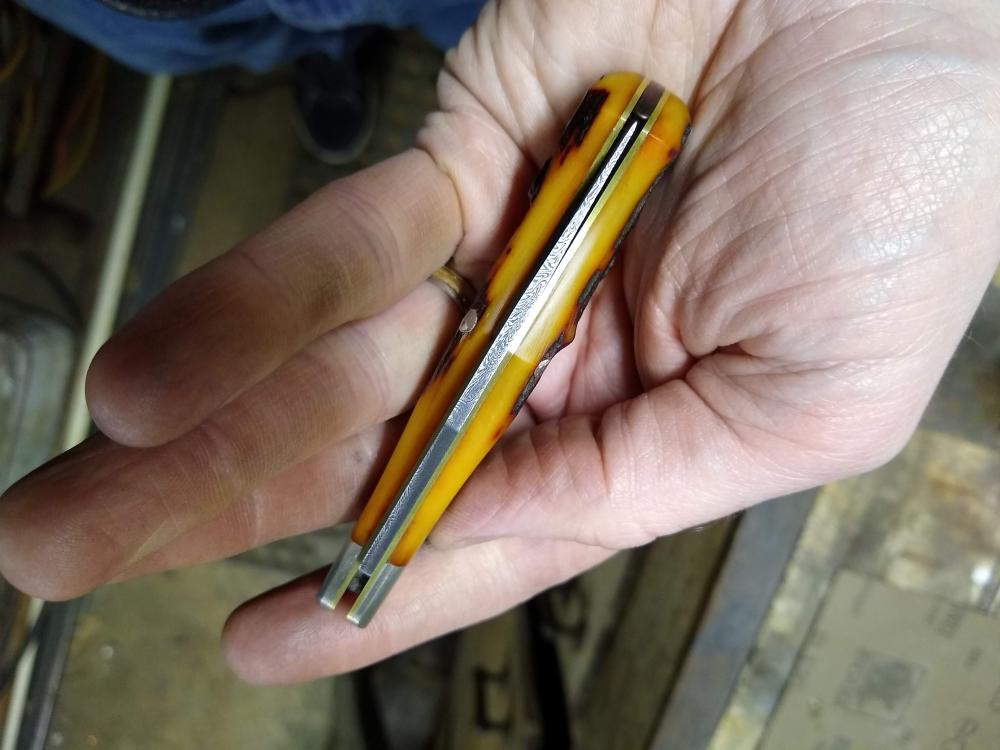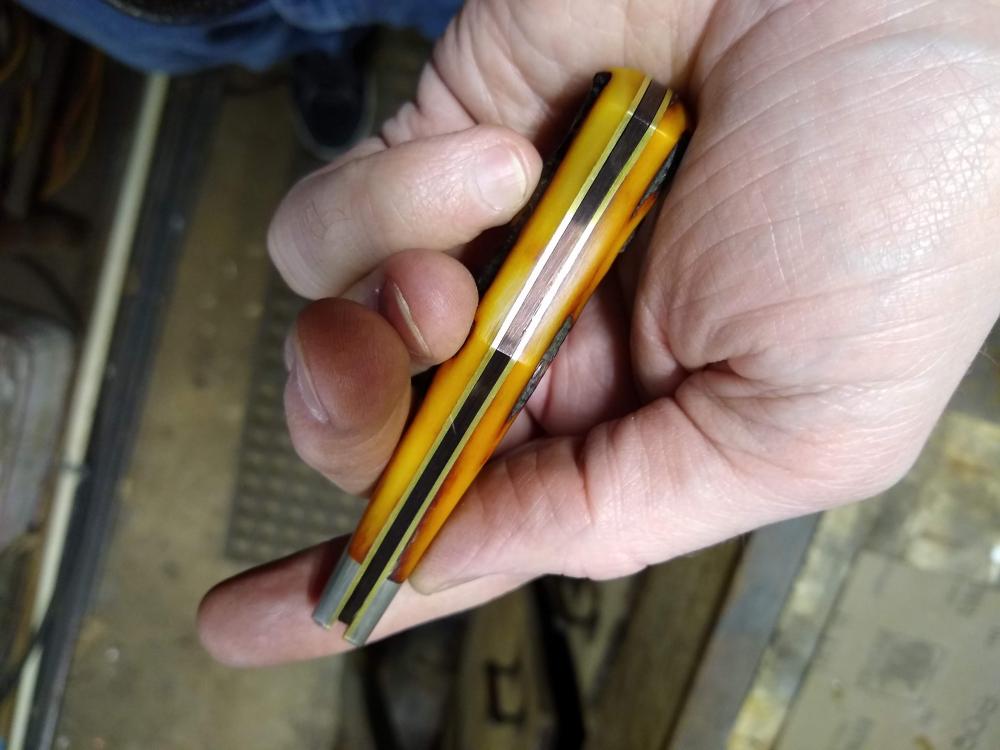
rhitee93
Members-
Posts
252 -
Joined
-
Last visited
Profile Information
-
Gender
Male
-
Location
West Central Indiana
-
Interests
Just about anything that uses my hands
Recent Profile Visitors
3,833 profile views
-
I love your work, and this video is no different. Looking forward to more. You scared me a bit with your cutting tests at around 20 seconds. I filleted my little finger from the tip to the bottom knuckle a few years ago because I lost track of where my hand was when slashing with a knife. If you ever go to cutting competitions you'll often see spectators shouting to remind contestants to put their off hand in a back pocket. Take this FWIW. I'm not a safety guru or anything
-
I haven't thought about that knife in a while I've been thinking about a folder for some of my father's cremains for a while now, but haven't made anything yet. My folders are all traditional looking slip-joints. Many would say boring or old fashioned. Feel free to shoot me a PM if that is something you might like. It might just get me off the dime on designing something.
-
Just had to dress the points on an old tiller last week. The last car I had to do that with was a '72 Spitfire, but I was still driving that car until 6 years ago.
-
There isn't an "Easy" way that I know of. Wrap the abrasive paper around something with a sharp corner, drag it down the face of the plunge, and then straight out towards the tip of the blade is one smooth movement. Resist the urge to rub "up and down" the plunge line from spine to belly because it makes even more scratches to get out. Plastic door shims make for a nice thing to wrap the paper around. Sometimes I loose patience, and jamb the paper into the corner with a push stroke from further out on the blade. This works pretty well too, but makes J swirls that you have to sand out later. Because you are using such a small area of the paper, you have to keep moving to a fresh section every few strokes. I find it helps to sand that area first. Once you get it to where you like it for a particular grit, sand the rest of the blade to the same grit level.
-
If it your first folder, then I would suggest starting with a simple slip-joint. Steve Culver has a great book on designing the mechanism for a slip-joint. The book comes with a template you can use as well. If you truly want a "Flipper", then you are probably looking for a liner lock design. However, I can't offer any guidance on designing one of those.
-
I think Glenn was suggesting those as sources of pin material, not as a wrap. Opinions vary on this, but I use the epoxy to seal the space between the tang and the handle material, and to hold the handle together until I get pins in. I always have rivets or peened pins to create a mechanical connection. On chef's knives, which I expect to get wet frequently, I use cutler's rivets. However, the handle has to be mostly shaped before they go in because you don't get nearly as much room to shape the head of the rivet as you would with a corby bolt. I epoxy on the scales, and do 90% of the shaping before counter-boring for the cutler's rivets.
-
I still pay a few bucks a month to keep my old land line, although it is really VOIP now. That is the phone number I hand out anytime I am required to give one. As a result, all of the spam and robo calls go there. The phone ringer is off.
-
What's your latest blade look like? Post em and let us see.
rhitee93 replied to HondoWalker's topic in Knife Making
Lol, thanks Daswulf. It's already been gifted to a friend -
What's your latest blade look like? Post em and let us see.
rhitee93 replied to HondoWalker's topic in Knife Making
This is a test blade for a mosaic pattern I was working on that will be appropriately scaled for pocket knives. It came out OK for a prototype... -
Forge welding question
rhitee93 replied to Buzzkill's topic in Knife making Class General Class Discussion
I hear you about fuel usage. lately I've been stacking up my welding projects until I have enough work to justify getting the forge up to temp. Still kind of a bummer to let things cool down. -
Forge welding question
rhitee93 replied to Buzzkill's topic in Knife making Class General Class Discussion
I pretty much stopped using flux a couple of years ago. I'll still crawl back to it for something with a complex geometry where I can't get it welded before I have oxidation issues, but none of my pattern welded billets get fluxed anymore. The kerosene dunk in not necessary if your forge environment is correct. It is not a flux, and the only benefit it brings is using up any oxygen that might have been trapped inside your stack before it has time to oxidize your steel. What you are fighting after your first weld was the forge scale that formed on the outside of your billet. In my opinion, the only way to get that to weld again without flux is to allow it to cool, and grind the mating surfaces clean. -
I like to use cutler's rivets for some knives. The price varies by size, but is right around your price point. Various knife making suppliers have them.
-
What's your latest blade look like? Post em and let us see.
rhitee93 replied to HondoWalker's topic in Knife Making
Oh, there are a nbumber of my folders out there in daily carry situations. My personal knife has held up better than the last 3 commercial pocket knives I had. (I'm a confessed knife abuser) A good pattern welded blade will hold up just fine. It won't improve performance, but if it's done right, it can perform just as well. -
What's your latest blade look like? Post em and let us see.
rhitee93 replied to HondoWalker's topic in Knife Making
George, IMHO, pattern welding is purely aesthetic these days. I don't think I can forge weld together anything that would outperform most (or any) of the modern steels that are available. I just like making pattern welded steel I make my own rivets from either stainless or nickel silver stock depending on the knife. I just hold the round stock in a 5C collet, and form a head with a tiny ball-peen hammer. Then I cut the rivet to length and peen it in place. I think I have some pics somewhere of the process if you want, but it may take a while to dig them up. I've gravitated towards 1075 for the springs, although I have dabbled with some in S35VN when I made some stainless blades. -
General question for the community, steel coatings for knives.
rhitee93 replied to Jclonts82's topic in Knife Making
Hmm. I'm as skeptical of miracle coatings as the next guy, but if it works as well as you have been lead to believe I could see it as a way to protect the surface finish on more expensive chef's knives. I kind of hate having to tell customers to "Allow the beautiful patina to grow" on a pattern welded kitchen knife that I have many hours of hand polish work on, and that they pay several hundred dollars for. There might be room for a ~$100 coating option on a $1k knife. Do you have any idea how it affects the sharpening process? I'd assume that once you get through it the coating would flake off easily as the steel underneath is honed away. If so it wouldn't cause much problem, ut you would have to get through the coating to put on the initial edge.






